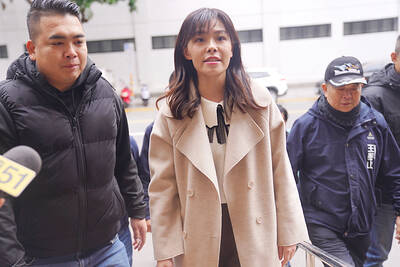Myanmar’s military leaders have extended their detention of deposed Burmese State Counselor Aung San Suu Kyi, whose remand was set to expire yesterday, and whose freedom is a key demand of the crowds of people continuing to protest this month’s military coup.
Aung San Suu Kyi would now be remanded until tomorrow, when she would likely appear in court by videoconference, said Khin Maung Zaw, a lawyer asked by Aung San Suu Kyi’s party to represent her.
The Nobel laureate remains under house arrest on a minor charge of possessing unregistered imported walkie-talkies.

Photo: AP
Aung San Suu Kyi’s extended detention is likely to further inflame tensions between the military, which seized power in a Feb. 1 coup, and the protesters who have taken to the streets of cities across the Southeast Asian nation seeking the return of the government they elected.
Protesters yesterday continued to gather across Myanmar following a night in which authorities cut the country’s Internet access and increased security presence in major cities seeking to curtail demonstrations.
Thousands of engineers marched on the streets of Mandalay, the country’s second-largest city, chanting and holding signs that read: “Free our leader,” “Who stands with justice?” and “Stop arresting people illegally at midnight.”
In Yangon, the country’s most populous city, fewer protesters gathered due to the loss of Internet and reports of military vehicles on the streets.
Nevertheless, more than 1,000 anti-coup demonstrators were outside the Central Bank of Myanmar building, where there were also military trucks full of soldiers, riot police, water-cannon trucks and armored personnel carriers.
Internet connectivity was later restored at about the start of the working day, with monitoring site Netblocks saying the blackout lasted about eight hours.
Demonstrators carried placards that read “#SupportCDM #SaveMyanmar.”
CDM refers to the civil disobedience movement that has seen doctors, engineers and others in Myanmar refuse to work until the military releases elected political leaders and returns the country to civilian rule.
Some protesters posed for photographs in front of military vehicles while holding red signs that said “Join in CDM.”
Security forces reportedly opened fire to disperse protesters in Mandalay, the Frontier Myanmar magazine wrote on Twitter, with an unidentified member of a student union in the city saying some people were wounded.
The report was not independently verified.
When the military seized power, it detained Aung San Suu Kyi and members of her government, and prevented recently elected lawmakers from opening a new session of parliament.
The junta, led by Senior General Min Aung Hlaing, said it stepped in because the government failed to properly investigate allegations of fraud in last year’s election, which Aung San Suu Kyi’s National League for Democracy party won in a landslide.
The state election commission refuted that contention, saying there is no evidence to support it.
The military justified its move by citing a clause in the 2008 constitution, implemented during military rule, that says in cases of national emergency, the government’s executive, legislative and judicial powers can be handed to the military commander-in-chief.
It is just one of many parts of the charter that ensured the military could maintain ultimate control over the country it ruled for 50 years following a 1962 coup. The military is allowed to appoint its members to 25 percent of seats in parliament and it controls of several key ministries involved in security and defense.
On Sunday, ambassadors from the US, Canada and 12 European nations called on Myanmar’s security forces to refrain from violence against those “protesting the overthrow of their legitimate government.”
They condemned the arrests of political leaders and advocates, as well as the military’s interference with communications.
“We support the people of Myanmar in their quest for democracy, freedom, peace, and prosperity,” they said in a joint statement issued late on Sunday night.
Additional reporting by AFP and Reuters, with staff writer

The US government has signed defense cooperation agreements with Japan and the Philippines to boost the deterrence capabilities of countries in the first island chain, a report by the National Security Bureau (NSB) showed. The main countries on the first island chain include the two nations and Taiwan. The bureau is to present the report at a meeting of the legislature’s Foreign Affairs and National Defense Committee tomorrow. The US military has deployed Typhon missile systems to Japan’s Yamaguchi Prefecture and Zambales province in the Philippines during their joint military exercises. It has also installed NMESIS anti-ship systems in Japan’s Okinawa

‘WIN-WIN’: The Philippines, and central and eastern European countries are important potential drone cooperation partners, Minister of Foreign Affairs Lin Chia-lung said Minister of Foreign Affairs Lin Chia-lung (林佳龍) in an interview published yesterday confirmed that there are joint ventures between Taiwan and Poland in the drone industry. Lin made the remark in an exclusive interview with the Chinese-language Liberty Times (the Taipei Times’ sister paper). The government-backed Taiwan Excellence Drone International Business Opportunities Alliance and the Polish Chamber of Unmanned Systems on Wednesday last week signed a memorandum of understanding in Poland to develop a “non-China” supply chain for drones and work together on key technologies. Asked if Taiwan prioritized Poland among central and eastern European countries in drone collaboration, Lin

BACK TO WORK? Prosecutors said they are considering filing an appeal, while the Hsinchu City Government said it has applied for Ann Kao’s reinstatement as mayor The High Court yesterday found suspended Hsinchu mayor Ann Kao (高虹安) not guilty of embezzling assistant fees, reducing her sentence to six months in prison commutable to a fine from seven years and four months. The verdict acquitted Kao of the corruption charge, but found her guilty of causing a public official to commit document forgery. The High Prosecutors’ Office said it is reviewing the ruling and considering whether to file an appeal. The Taipei District Court in July last year sentenced Kao to seven years and four months in prison, along with a four-year deprivation of civil rights, for contravening the Anti-Corruption

NO CONFIDENCE MOTION? The premier said that being toppled by the legislature for defending the Constitution would be a democratic badge of honor for him Premier Cho Jung-tai (卓榮泰) yesterday announced that the Cabinet would not countersign the amendments to the local revenue-sharing law passed by the Legislative Yuan last month. Cho said the decision not to countersign the amendments to the Act Governing the Allocation of Government Revenues and Expenditures (財政收支劃分法) was made in accordance with the Constitution. “The decision aims to safeguard our Constitution,” he said. The Constitution stipulates the president shall, in accordance with law, promulgate laws and issue mandates with the countersignature of the head of the Executive Yuan, or with the countersignatures of both the head of the Executive Yuan and ministers or